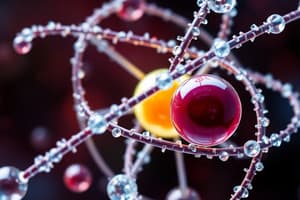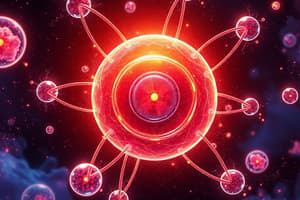Podcast
Questions and Answers
What are the two main regions that compose an atom?
What are the two main regions that compose an atom?
- The protons and the electrons
- The nucleus and the electron shells (correct)
- The protons and the neutrons
- The electrons and the neutrons
Which particles determine the atomic number of an element?
Which particles determine the atomic number of an element?
- Neutrons only
- Both protons and neutrons
- Protons only (correct)
- Electrons
What is the charge of an electron?
What is the charge of an electron?
- -2 (correct)
- Different from proton charge
- +1
- 0
According to the Aufbau principle, how are electrons arranged within an atom?
According to the Aufbau principle, how are electrons arranged within an atom?
Which model established the concept of atoms as indivisible building blocks of matter?
Which model established the concept of atoms as indivisible building blocks of matter?
What key contribution of neutrons and protons to an atom's properties is mentioned in the text?
What key contribution of neutrons and protons to an atom's properties is mentioned in the text?
Which atomic model did not account for the nucleus of an atom?
Which atomic model did not account for the nucleus of an atom?
Who first introduced the concept of the nucleus in an atom?
Who first introduced the concept of the nucleus in an atom?
Which atomic model describes electrons as not uniformly distributed throughout the atom's volume?
Which atomic model describes electrons as not uniformly distributed throughout the atom's volume?
In the Atomic Models, where are protons and neutrons confined?
In the Atomic Models, where are protons and neutrons confined?
Which atomic model envisions the atom as a sphere of positive charge with negative charge embedded in it?
Which atomic model envisions the atom as a sphere of positive charge with negative charge embedded in it?
What does the Quantum Mechanical Model describe?
What does the Quantum Mechanical Model describe?
Study Notes
Understanding the Structure of the Atom
The structure of the atom is one of the fundamental concepts in modern science, providing a framework for understanding the behavior of matter at the atomic level. Atoms, the smallest unit of an element, are composed of two main regions: the nucleus and the outer region, which holds the electrons in orbit around the nucleus.
The Nucleus
At the center of the atom is the nucleus, where protons and neutrons reside. Protons, positively charged particles, determine the atomic number of an element. Neutrons, uncharged particles, have the same mass as protons and are found within the nucleus. Together, protons and neutrons contribute to the mass of the atom.
Electrons
Surrounding the nucleus is the outer region of the atom, which is composed of electron shells. Each electron has a negative charge (-1), equal to the positive charge of a proton (+1). Electrons are responsible for the chemical reactivity of an atom and are arranged according to the Aufbau principle, which states that electrons enter subshells of an atom in the order of increasing energy level.
Atomic Structure Models
Several models have been proposed to understand the structure of the atom, each contributing to our current understanding of atomic composition and behavior. Some key models include:
-
Dalton's Atomic Theory: Proposed by John Dalton in 1804, this theory established the concept of atoms as indivisible building blocks of matter. Atoms of the same element are identical, while atoms of different elements differ in size and mass.
-
Thomson's Atomic Model: Thomas Thomson envisioned the atom as a sphere of positive charge with negative charge embedded in it. This model did not account for the nucleus of an atom.
-
Rutherford's Atomic Model: Ernest Rutherford's model, proposed in 1911, introduced the concept of the nucleus. Protons and neutrons are confined in a small region inside the atom called the nucleus, while electrons revolve around the nucleus.
-
Quantum Mechanical Model: This model, based on the principles of quantum mechanics, describes the electron distribution within an atom. Electrons are not uniformly distributed throughout the atom's volume, but rather are distributed according to a set of principles described by quantum mechanics.
In summary, the structure of an atom is composed of a nucleus containing protons and neutrons, surrounded by a cloud of electrons in various electron shells. Understanding atomic structure is crucial for understanding chemical reactions, properties of elements and compounds, and the behavior of materials at the molecular and atomic levels.
Studying That Suits You
Use AI to generate personalized quizzes and flashcards to suit your learning preferences.
Description
Learn about the fundamental concepts of atomic structure, including the nucleus, electron arrangement, and key atomic models like Dalton's theory and the Quantum Mechanical model. Explore the composition of atoms and how they contribute to the behavior of matter at the atomic level.




